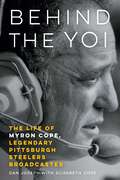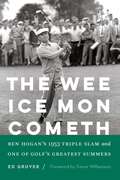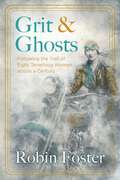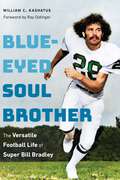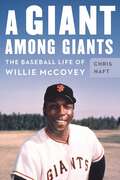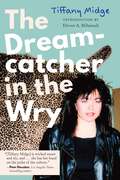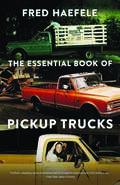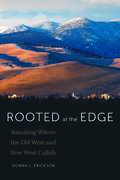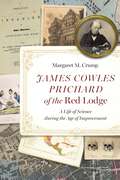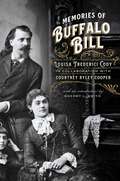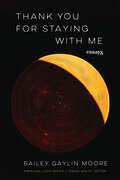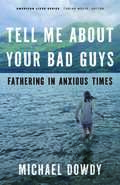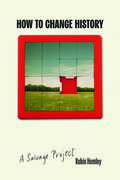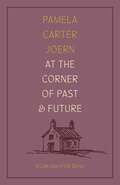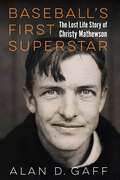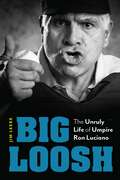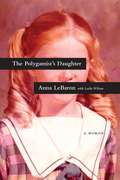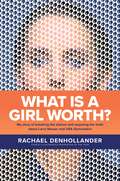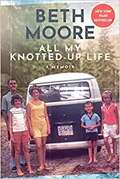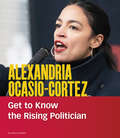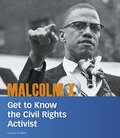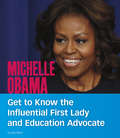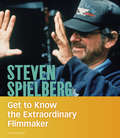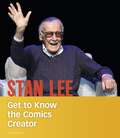- Table View
- List View
Behind the Yoi: The Life of Myron Cope, Legendary Pittsburgh Steelers Broadcaster
by Dan Joseph Elizabeth CopeMyron Cope was the color commentator for Pittsburgh Steelers radio broadcasts from 1970 to 2005, the second-longest-serving team broadcaster in NFL history. At the peak of his popularity, an estimated 50 percent of Steeler fans turned down the volume on their TVs so they could listen to the radio as Cope, in his one-of-a-kind scratchy, raspy voice, barked out phrases like &“Yoi&” and &“Okle-dokle,&” often fueled by bursts of excitability and his own beautiful brand of homerism. About his voice, Cope said, &“Mine isn&’t a broadcaster&’s voice; it tends to cut through concrete.&” Cope helped forge the unbreakable bond between the city of Pittsburgh and its football team. His evening talk show, one of the first sports talk programs in the nation, dominated its time slot for more than twenty years, and he became the first pro football announcer elected to the National Radio Hall of Fame. Born in Pittsburgh to parents of Lithuanian Jewish ancestry, Cope attended the University of Pittsburgh and became a journalist. Though he forged a successful career writing for magazines like Sports Illustrated, football fans grew to know Cope far more through the airwaves. Co-namer of the Immaculate Reception, he also created the Terrible Towel, the flag of Steelers Nation, when in 1975 he urged fans to bring gold towels to wave at a playoff game against the Baltimore Colts. Behind the scenes the Terrible Towel took on a deeper personal meaning, as Cope eventually assigned all royalties from the towels to the facility where his son, who was born with brain damage and never learned to speak, still resides. Throughout his life Cope, who passed away in 2008, raised hundreds of thousands of dollars for children with disabilities. Using Cope&’s own papers, correspondence, and tapes, plus interviews with friends and family, Dan Joseph and Elizabeth Cope, Myron&’s daughter, paint the first three-dimensional portrait of the creative, many-faceted man whom Pittsburghers still hold in high esteem and close to their hearts.
The Wee Ice Mon Cometh: Ben Hogan's 1953 Triple Slam and One of Golf's Greatest Summers
by Ed GruverIt is considered by many the greatest season in golf history. In 1953 Ben Hogan provided a fitting exclamation point to his miraculous comeback from a near-fatal auto accident by becoming the first player to win golf&’s Triple Crown—the Masters, the U.S. Open, and the British Open—within a span of four months. It was closer than anyone had gotten to the modern-day Grand Slam of winning all four of golf&’s major tournaments.The Wee Ice Mon Cometh is the first book to detail Hogan&’s historic accomplishment. His 1953 season remains the world&’s greatest, and golfers seek to match his achievement every year. Bobby Jones in 1930 and Tiger Woods in 2000–2001 achieved comparable &“slams,&” but the Hogan Slam stands alone due to the car crash four years before that left Hogan on shattered legs. He nonetheless won with record-setting performances on three of the most challenging courses in the world: Augusta National at the Masters, the U.S. Open at Oakmont, and the British Open at Carnoustie, Scotland. Ed Gruver weaves together interviews with members of Hogan&’s family, golf historians, playing partners, and business partners along with extensive research and eyewitness accounts of each tournament. Seventy years after his historic feat, the Hogan Slam still serves as a symbol for the many comebacks Hogan had to make throughout his life—his father&’s death by suicide when Ben was a boy, desperate days during the Great Depression, frustrating failures in tournaments early in his career, and the horrific accident that nearly killed him just as he was finally reaching the pinnacle of his profession.
Grit and Ghosts: Following the Trail of Eight Tenacious Women across a Century
by Robin FosterAs a student and teacher of history, Robin Foster is well aware that humans have persisted through major hardships as long as they have existed. When faced with the anxious dread many felt at the beginning of the COVID-19 pandemic, Foster began seeking stories of tenacious women of the American West who had survived their own hardships in a world that threw the unexpected at them. During one of the most uncertain periods of her life, Foster hit the road, embarking on a journey to find these determined women of the past and finding herself along the way. Grit and Ghosts tells the stories of eight women who speak to a shared human experience of struggle, and the grit required to move through it. Landscape and memory become deeply intertwined throughout Grit and Ghosts as Foster wanders through park ranger Marguerite Lindsley&’s Yellowstone, through Mexican faith healer Teresa Urrea&’s Sonoran Desert, and through author Gertrude Stein&’s deeply altered Oakland. Part excavation, part resurrection, Grit and Ghosts is permeated with the individual and collective memories of Foster and her subjects, like ghosts of history.
Blue-Eyed Soul Brother: The Versatile Football Life of Super Bill Bradley
by William C. KashatusBlue-Eyed Soul Brother tells the life story of NFL All-Pro free safety Bill Bradley, who was known on the gridiron as much for his fierce competitiveness as he was for his whimsical nonconformity off it. Bradley was among the first NFL players to hold out for a bigger salary and challenge the status quo with his long hair, bushy mustache, and free-spirited lifestyle. Beginning in high school, Bradley stood up for the civil rights of his Black teammates and was instrumental in breaking down the color barrier in Texas high school football. A highly recruited scholastic quarterback, Bradley played for the University of Texas Longhorns for three seasons. Unable to run the Wishbone offense, Bradley was demoted and switched to defensive back, where he reinvented himself as a ball hawk. After being drafted by the lowly Philadelphia Eagles, he became a triple threat who punted, returned, and played free safety and was the first player to lead the NFL in interceptions in consecutive seasons. After a thirty-year coaching career in the World Football, Canadian Football, and National Football Leagues, Bradley retired to his native Texas. There, he and his wife, Susan, cared for their son, Matt, a talented college quarterback who became a paraplegic after a savage assault by a drunk college student. Matt made a heroic eleven-year effort to regain the use of his voice and motor skills before he died in 2020. Today, Bradley is engaged in another struggle, this one with memory loss and other cognitive impairments caused by the many concussions he suffered during his nine-year playing career in the NFL. But he is determined to live his life to the fullest.Blue-Eyed Soul Brother is the inspirational story of a man whose contagious enthusiasm for life raised the spirits of those around him in both good and bad times—a story about the resilience of the human spirit in the face of personal tragedy, and a story to remember when life doesn&’t appear to be going your way.
A Giant among Giants: The Baseball Life of Willie McCovey
by Chris HaftWillie McCovey, known as &“Stretch,&” played Major League Baseball from 1959 to 1980, most notably as a member of the San Francisco Giants for nineteen seasons. A fearsome left-handed power hitter, McCovey ranked second only to Babe Ruth in career home runs among left-handed batters and tied for eighth overall with Ted Williams at the time of his retirement. He was a six-time All-Star, three-time National League home run champion, and 1969 league MVP, and he was inducted into the Baseball Hall of Fame in 1986 in his first year of eligibility. Known as a dead-pull line drive hitter, McCovey was called &“the scariest hitter in baseball&” by pitcher Bob Gibson. Born in Mobile, Alabama, McCovey encountered daunting hurdles, such as Jim Crow laws that prevented him from playing organized ball as a youth and playing for Major League managers such as Tom Sheehan and Alvin Dark, who took a dim view of his abilities. But neither that nor other difficulties on the field—the platooning, the slights, the unrelenting injuries—seemed to affect McCovey, as he remained grateful to be playing baseball. McCovey was the most treasured Bay Area icon of all, a humble, approachable superstar who earned the admiration of seemingly everyone he encountered. McCovey&’s life wasn&’t measured in his home run and RBI totals, though those were impressive. His greatest significance lay in the warmth and respect he extended and which others reciprocated. These elements elevated McCovey to a pantheon where relatively few athletes reside. He remains synonymous with not just the team he ennobled but also the city he represented. In A Giant among Giants, the first biography of McCovey, who passed away in 2018 at the age of eighty, Chris Haft tells the story of one of baseball&’s best hitters and most-beloved players.
The Dreamcatcher in the Wry
by Tiffany MidgeThe Dreamcatcher in the Wry, Tiffany Midge&’s bitingly hilarious collection of essays written during the COVID-19 pandemic, builds on the critical acclaim of her earlier book Bury My Heart at Chuck E. Cheese&’s. A Standing Rock Sioux citizen, Midge offers up her unique satire about the foibles of politics, consumerism, world affairs, pandemic anxieties, and other subjects from the pandemic years of 2020 through 2023.The Dreamcatcher in the Wry brims with insight, considering pig heart transplants, wedding-crashing grizzly bears, truffle-snuffling dogs, bison-petting tourists—and a plethora of other animal and wildlife hijinks—not to mention wienermobiles, the controversial Mount Rushmore, meeting Iron Eyes Cody in a parade, Elizabeth Warren&’s quaint family lore, and Buffy Sainte-Marie. Midge brilliantly unpacks her observations and day-to-day concerns through the lens of an urban-raised Lakota living in the West, a writer of poetry, op-eds, church bulletins, fridge magnets, and Twitter posts who is allergic to horses and most outdoor recreation—except for berry picking and the occasional romp through a dewy meadow. Turning over the colonizer&’s society and culture for some good old Native American roasting, Midge informs as she entertains, gleaning wisdom from the incongruities of daily life with a much-needed dose of Indigenous common sense.
The Essential Book of Pickup Trucks
by Fred HaefeleOf the sixty million pickups on U.S. highways today, just one in eight was bought for work purposes. The remaining fifty-four million are what truck dealers call &“lifestyle purchases.&” Does the pickup impulse spring from some deep, organic longing? For agrarian roots, for simpler times, for a driving experience larger than life?The Essential Book of Pickup Trucks is a memoir about the complex role pickups have played in Fred Haefele&’s life and in American culture at large. Growing up near the GM truck plant in Flint, Michigan, young Haefele was delighted by these centaur-like vehicles. In his adult life as an arborist, teacher, and father, pickups bore him through hard times and disaster, high adventure, triumph, and love. Through his tenure with twelve trucks, Haefele recounts his experiences with tree climbing and academia, masculinity and motor culture. For Haefele, pickup trucks hold a unique place in the American psyche—equal parts fantasy steed and dray horse, they&’re avatars of the American spirit. The Essential Book of Pickup Trucks is, like his trucks, uniquely free-spirited: love story, blue-collar writer&’s tale, and motor-head memoir.
Rooted at the Edge: Ranching Where the Old West and New West Collide
by Donna L. EricksonRooted at the Edge paints a portrait of a ranching community in a threatened landscape steeped in history, conflict, and beauty. In this narrative nonfiction work, Donna L. Erickson explores the hilly skirt of ground at the northern boundary of Missoula, Montana, separating the town from the wilderness beyond. The North Hills region represents the critical—and often highly personal—issues at play at the edge of many western towns. The urban-rural fringe is both valuable and vulnerable. Across the West rural lifestyles are increasingly compromised by suburbanization, economic hardship, and family dynamics; a way of life and a way of work are vanishing. Ranchland may be simultaneously cherished by a family for the life its members have made there and coveted by urban neighbors for open space. Community residents may love a place for its scenery and wildlife habitat while others wish it converted to a commercial parking lot. Complex ecological relationships can be bulldozed in a single afternoon. And the threats of climate change and shifting populations compromise the edge even more. In the tension between love and loss, Erickson wrote this story of a landscape&’s soft contours, piney ridges, shady draws, and grassy slopes, and its potential disappearance under an expanding city. Rooted at the Edge conveys, in a way that statistics cannot, what&’s at stake when ranches at the urban fringe are threatened.
James Cowles Prichard of the Red Lodge: A Life of Science during the Age of Improvement (Critical Studies in the History of Anthropology)
by Margaret M. CrumpMargaret M. Crump offers the first thorough biography of British scientist and physician James Cowles Prichard (1786–1848), an intellectual giant in the developing human sciences, a pioneering psychiatric theorist, and Europe&’s leading anthropologist during the first half of the nineteenth century.
Memories of Buffalo Bill (The Papers of William F. "Buffalo Bill" Cody)
by Louisa Frederici CodyWritten with the help of Courtney Ryley Cooper, Memories of Buffalo Bill offers an idealized account of William F. Cody&’s life from the perspective of his wife, Louisa. True to its origins, this account offers many more details about Cody&’s domestic life, including his children, than any other preceding work. Although William and Louisa&’s real-life marriage was marred by some high-profile scandals, it endured until her husband&’s death in 1917.Memories of Buffalo Bill, the first biography of William F. Cody to appear after his death, strikes a celebratory tone in narrating highlights of his life and enterprises. Through its introduction, notes, and appendixes, this edition offers a broader context for the Codys&’ marriage, evidencing its private realities and the collaboration required to preserve the Buffalo Bill image in the public eye. Out of print since its first publication, Louisa Cody&’s memoir highlights the processes involved in crafting and preserving a national myth. Both for what it does and does not say, it was the first step in laying a foundation for the enduring legacy of Buffalo Bill as an American icon.
Thank You for Staying with Me: Essays (American Lives)
by Bailey Gaylin MooreUrgent, meditative, and searching, Thank You for Staying with Me is a collection of essays that navigates the complexities of home, the vulnerability of being a woman, mother-daughter relationships, and young motherhood in the conservative and religious landscape of the Ozarks. Using cosmology as a foil to discuss human issues, Bailey Gaylin Moore describes praying to the sky during moments of despondency, observing a solar eclipse while reflecting on what it means to be in the penumbra of society, and using galaxy identification to understand herself. During a collision of women&’s rights, gun policy, and racial tension, Thank You for Staying with Me is a frank and intimate rumination on how national policy and social attitudes affect both the individual and the public sphere, especially in such a conservative part of the United States.
Tell Me about Your Bad Guys: Fathering in Anxious Times (American Lives)
by Michael DowdyMichael Dowdy perceives the world as a poet, one with an anxiety disorder. As a result he has rarely experienced fathering or his relationship with his daughter, A, as a linear narrative. Rather, his impressions of fathering coalesce in encounters with the conditions of our time, producing intense flashes of awareness and emotion. Critiquing his own fathering practices, Dowdy&’s essays move between simplicity—being present for his daughter—and complexity—considering the harrowing present of entrenched misogyny, school shootings, climate change, and other threats to childing and fathering with love, optimism, and joy. The essays in Tell Me about Your Bad Guys do not provide easy answers. They follow instead an interrogative mode, guided by A&’s unruly questions and Dowdy&’s desire to avoid fatherhood literature&’s traps: false modesty, antic ineptitude, and defensive clowning. This means understanding fathering not as an ironclad identity or a cohesive story but as a process of trial and error, self-reflection, and radical openness. With measures of dark humor, the essays take seriously the literary, material, and political stakes of fathering and in doing so challenge patriarchal norms and one-dimensional accounts of fatherhood.
How to Change History: A Salvage Project
by Robin HemleyIn How to Change History Robin Hemley grapples with the individual&’s navigation of history and the conflict between personal and public histories. In an attempt to restore, resurrect, and reclaim what might otherwise be lost, Hemley meditates and speculates on photography, scrapbooks, historical markers, travelogues, TV shows, real estate come-ons, washed up rock stars, incontinent dachshunds, stalkers, skeletons in the closet, and literature. He also examines his parents&’ lives as writers, documenting their under-seen influence on the art movements of the day. In one essay, he writes about his mother&’s first cousin, Roy, a survivor of Pearl Harbor whose troubled daughter murdered him. The essay &“Jim&’s Corner&” examines the notion of memorial plaques and how they often highlight erasure rather than forestall it. Hemley writes about a stranger whose World War II experiences were chronicled in a scrapbook Hemley bought at an estate sale. In this book about reconstruction, Hemley posits that while we cannot change events once they have passed, we can return to those events to learn and sometimes perhaps change our understanding of them.
At the Corner of Past and Future: A Collection of Life Stories
by Pamela Carter JoernWith keen observation and deep reflection, Pamela Carter Joern probes her life. No topic is too small or too sacred, from gutting chickens to Gaudí&’s cathedral. Through a range of experiences—growing up in rural Nebraska, raising children, surviving cancer, becoming a writer—she explores the tenuous link between memory and truth. Joern displays a gift for mining wisdom through surprising connections, juxtaposing her father&’s life to the discoveries of Isaac Newton or the writer&’s task to the ancient art of alchemy. She weds philosophical insight and spiritual imagination and laces this amalgam with candor and wit, resulting in a work that is engaging, intimate, and illuminating.
Baseball's First Superstar: The Lost Life Story of Christy Mathewson
by Alan D. GaffIf there was a first face of baseball, it was arguably Christopher &“Christy&” Mathewson. At the opening of the twentieth century, baseball was considered an undignified game played by ruffians for gamblers&’ benefit. Mathewson changed all that. When he signed with the Giants in 1900, his contract stated he wouldn&’t pitch on Sundays, and he was known for his honesty, integrity, and good looks. In his first fourteen seasons, as a pitcher for the Giants, Mathewson never won fewer than twenty games in a season, and he almost single-handedly won the 1905 World Series. In 1918, though age thirty-eight and exempt from military service, he enlisted for World War I, where he exposed himself to nearly lethal amounts of mustard gas as he taught soldiers how to put on gas masks. When he returned home, he was diagnosed with lung problems and tuberculosis, which led to his untimely death at the age of forty-five. After Mathewson&’s death, his eulogies were many, but it was impossible to catch the essence of his life in a single newspaper column. Jane Mathewson, his widow, was determined to provide the reading public with a more intimate portrait of her husband and approached prominent sportswriter Bozeman Bulger, who had known Mathewson for twenty years. Bulger wrote a series of articles titled &“The Life Story of Christy Mathewson.&” His portraits about the player were amplified by original accounts from Jane, and several unpublished chapters from Mathewson himself, which had been discovered among his papers. These combined accounts allow readers to hear from Mathewson and those who knew him best. A superstar long before that term was coined, Mathewson became an icon of sportsmanship. He was posthumously elected to the Baseball Hall of Fame at its first induction ceremony in 1936. In Baseball&’s First Superstar Alan D. Gaff brings Mathewson to life through Mathewson&’s own writings and those of others, largely lost to history until now.
Big Loosh: The Unruly Life of Umpire Ron Luciano
by Jim LeekeRon Luciano was a college football star, baseball umpire, TV broadcaster, and best-selling author. He barged through the world with an outsized personality, entertaining many, offending a few, and hiding behind a cheerful and outrageous persona until life somehow proved unbearable. Everyone knew him, but nobody really did. Once an All-American tackle at Syracuse University, Luciano turned to umpiring after an injury derailed his professional football career, and he quickly moved up the Minor League ladder to reach the Majors in 1969. As a big, likable loser—Oliver Hardy in blue—he became a fan favorite in the American League, &“shooting&” runners with his forefinger, conducting a legendary feud with Baltimore Orioles manager Earl Weaver, and entertaining writers with outlandish baseball stories—some of which were even true. Even as he added years to his umpiring career and was considered among the game&’s best, some players and managers thought his showmanship detracted from his abilities. He later became a baseball color analyst on national TV before coauthoring a series of rollicking best-selling sports books. Away from the game, he loved Shakespeare and birdwatching. But his upbeat public face was at odds with his private struggle with depression. His suicide at age fifty-seven shocked and puzzled friends, fans, and readers alike. In Big Loosh Jim Leeke recounts Luciano&’s unlikely career, detailing his life as athlete, arbiter, sportscaster, writer, and mythmaker while separating fact from fiction amid the fanciful stories he loved to spin. As a friend said of Luciano, &“If you didn&’t like this man, you didn&’t like people.&”
The Polygamist's Daughter: A Memoir
by Anna LeBaron Leslie WilsonMy father had thirteen wives and more than fifty children . . . This is the haunting memoir of Anna LeBaron, daughter of the notorious polygamist and murderer Ervil LeBaron. Ervil’s criminal activity kept Anna and her siblings constantly on the run from the FBI. Often starving, the children lived in a perpetual state of fear—and despite their numbers, Anna always felt alone. Would she ever find a place she truly belonged? Would she ever be anything other than the polygamist’s daughter? Filled with murder, fear, and betrayal, The Polygamist’s Daughter is the harrowing, heart-wrenching story of a fatherless girl and her unwavering search for love, faith, and a place to call home.
What is a Girl Worth
by Rachael DenhollanderRachael Denhollander’s voice was heard around the world when she spoke out to end the most shocking US gymnastics scandal in history. The first victim to publicly accuse Larry Nassar, the former USA Gymnastics team doctor who sexually abused hundreds of young athletes, Rachael now reveals her full story for the first time. How did Nassar get away with it for so long? How did Rachael and the other survivors finally stop him and bring him to justice? And how can we protect the vulnerable in our own families, churches, and communities?
All My Knotted-Up Life: A Memoir
by Beth MooreAn incredibly thoughtful, disarmingly funny, and intensely vulnerable glimpse into the life and ministry of a woman familiar to many but known by few. “It’s a peculiar thing, this having lived long enough to take a good look back. We go from knowing each other better than we know ourselves to barely sure if we know each other at all, to precisely sure that we don’t. All my knotted-up life I’ve longed for the sanity and simplicity of knowing who’s good and who’s bad. I’ve wanted to know this about myself as much as anyone. This was not theological. It was strictly relational. God could do what he wanted with eternity. I was just trying to make it here in the meantime. As benevolent as he has been in a myriad of ways, God has remained aloof on this uncomplicated request.”
Thomas Edison and the Lightbulb (Inventions And Discovery Ser.)
by Scott R. WelvaertIn graphic novel format, tells the story of Thomas Edison's involvement in the development of the incandescent lightbulb <P><P> <i>Advisory: Bookshare has learned that this book offers only partial accessibility. We have kept it in the collection because it is useful for some of our members. Benetech is actively working on projects to improve accessibility issues such as these.</i>
Alexandria Ocasio-Cortez: Get to Know the Rising Politician (People You Should Know)
by Leticia SnowAlexandria Ocasio-Cortez, often known as AOC, wrote her name in the history books in 2018 when she became the youngest woman ever elected to the U.S. Congress. Her fearless, meteoric rise from paycheck-to-paycheck to the House of Representatives and her tireless advocacy for a world inclusive of all peoples will fascinate readers.
Malcolm X: Get to Know the Civil Rights Activist (People You Should Know)
by Ebony Joy WilkinsMalcolm X is known as a leader of the civil rights movement. He faced racism, spent time in prison, became a minister, joined the Nation of Islam, left, took a pilgrimage to Mecca, traveled the world, and became a public figure before his assassination. Explore how his words shaped the civil rights movement and the people who called him a leader.
Michelle Obama: Get to Know the Influential First Lady and Education Advocate (People You Should Know)
by Lakita WilsonThe first black First Lady in U.S. history (and one of the most beloved), Michelle Obama brought intelligence and passion to her role. Readers will learn how her years as a daughter, student, lawyer, wife, and mother shaped her into the influential education, healthy living, and women's rights advocate she is today.
Steven Spielberg: Get to Know the Extraordinary Filmmaker (People You Should Know)
by Judy GreenspanSteven Spielberg has changed the cinematic world with his hugely popular films. Testing out new technology, telling dramatic stories, and collaborating with successful directors, actors, and producers helped build Spielberg's reputation as a director and producer.
Stan Lee: Get to Know the Comics Creator (People You Should Know)
by Cristina OxtraStan Lee is one of the most influential people in the comic book world. The memorable heroes he created, including Spider-Man, Iron Man, the X-Men, and Daredevil, helped build Marvel Comics into the publishing powerhouse we know today.
